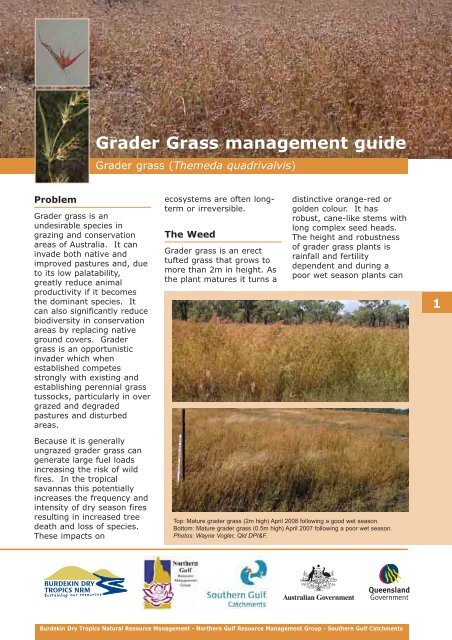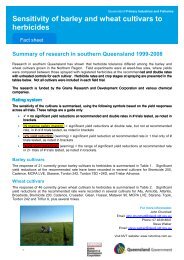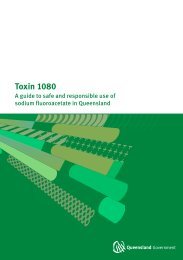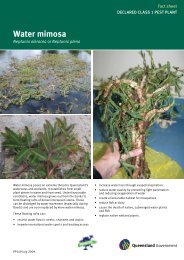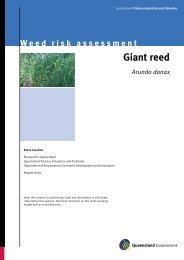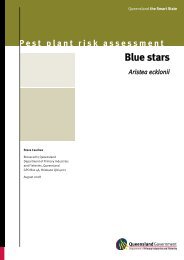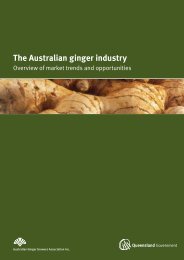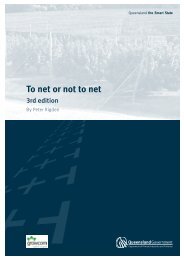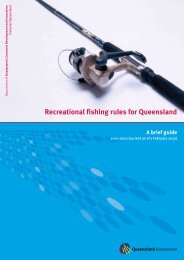Grader Grass management guide
Grader Grass management guide
Grader Grass management guide
Create successful ePaper yourself
Turn your PDF publications into a flip-book with our unique Google optimized e-Paper software.
Problem<br />
<strong>Grader</strong> grass is an<br />
undesirable species in<br />
grazing and conservation<br />
areas of Australia. It can<br />
invade both native and<br />
improved pastures and, due<br />
to its low palatability,<br />
greatly reduce animal<br />
productivity if it becomes<br />
the dominant species. It<br />
can also significantly reduce<br />
biodiversity in conservation<br />
areas by replacing native<br />
ground covers. <strong>Grader</strong><br />
grass is an opportunistic<br />
invader which when<br />
established competes<br />
strongly with existing and<br />
establishing perennial grass<br />
tussocks, particularly in over<br />
grazed and degraded<br />
pastures and disturbed<br />
areas.<br />
Because it is generally<br />
ungrazed grader grass can<br />
generate large fuel loads<br />
increasing the risk of wild<br />
fires. In the tropical<br />
savannas this potentially<br />
increases the frequency and<br />
intensity of dry season fires<br />
resulting in increased tree<br />
death and loss of species.<br />
These impacts on<br />
<strong>Grader</strong> <strong>Grass</strong> <strong>management</strong> <strong>guide</strong><br />
<strong>Grader</strong> grass (Themeda quadrivalvis)<br />
ecosystems are often longterm<br />
or irreversible.<br />
The Weed<br />
<strong>Grader</strong> grass is an erect<br />
tufted grass that grows to<br />
more than 2m in height. As<br />
the plant matures it turns a<br />
distinctive orange-red or<br />
golden colour. It has<br />
robust, cane-like stems with<br />
long complex seed heads.<br />
The height and robustness<br />
of grader grass plants is<br />
rainfall and fertility<br />
dependent and during a<br />
poor wet season plants can<br />
Top: Mature grader grass (2m high) April 2008 following a good wet season.<br />
Bottom: Mature grader grass (0.5m high) April 2007 following a poor wet season.<br />
Photos: Wayne Vogler, Qld DPI&F.<br />
Burdekin Dry Tropics Natural Resource Management - Northern Gulf Resource Management Group - Southern Gulf Catchments<br />
1
2<br />
grow as little as 40cm high.<br />
Typically land managers<br />
could expect to see grader<br />
grass plants growing to 1 –<br />
1.5m in an average wet<br />
season. In the seasonally<br />
dry tropics grader grass<br />
usually behaves as an<br />
annual although it may also<br />
survive as a short-lived<br />
perennial under moist<br />
conditions where frost does<br />
not occur.<br />
The grass is able to grow<br />
rapidly, sometimes reaching<br />
more than 2m in height<br />
<strong>Grader</strong> grass seed.<br />
Photo: Wayne Vogler, QLD DPI&F.<br />
within 6-8 weeks and<br />
yielding more than 5000<br />
kg/ha after one growing<br />
season. Seed heads<br />
generally appear between<br />
February and June in<br />
Australia but may occur<br />
outside of this period<br />
depending on climatic<br />
conditions such as timing<br />
and duration of rainfall.<br />
Seed heads can appear<br />
within 5-6 weeks of<br />
germination, with mature<br />
seed being present after 10<br />
weeks.<br />
<strong>Grader</strong> grass is a prolific<br />
seeder with as many as<br />
1000 seeds being produced<br />
in one seed head under<br />
ideal conditions. Soil seed<br />
banks can contain up to<br />
20 000 seeds per square<br />
metre under dense<br />
infestations following the<br />
growing season. These<br />
seed banks can decline<br />
rapidly. Within 15 to 18<br />
months, the viability of seed<br />
at or near the soil surface is<br />
almost zero. However, 30%<br />
of seed buried at 5cm or<br />
seed in well grassed areas<br />
remains viable after 18<br />
months. Disturbance (such<br />
as grading fire breaks or<br />
tracks) can expose this seed<br />
to favourable conditions for<br />
germination causing areas<br />
that appear free of grader<br />
grass to become reinfested.<br />
This rapid decline in the soil<br />
Mass <strong>Grader</strong> <strong>Grass</strong> seedling emergence following a single rainfall event in Dec 2006.<br />
Photo: Wayne Vogler, QLD DPI&F<br />
seed bank indicates that<br />
grader grass relies on<br />
frequent seed input rather<br />
than persistent soil seed<br />
banks for long-term<br />
survival. It also indicates<br />
that <strong>management</strong> of the<br />
seed bank (reducing seed<br />
input and seedling<br />
establishment) is critical to<br />
the long term success of<br />
grader grass <strong>management</strong>.<br />
Fresh grader grass seed<br />
tends to be dormant, i.e.<br />
seed is healthy but not<br />
inclined to germinate even<br />
in ideal conditions. The<br />
dormancy of grader grass<br />
seed declines from 60% at<br />
two months after maturity<br />
to less than 10% at eight<br />
months after maturity. In<br />
tropical Australia this<br />
ensures that high levels of<br />
germinable seed are<br />
available when the first rains<br />
of the wet season occur<br />
between October and<br />
January.<br />
In northern Australia, mass<br />
germination and emergence<br />
(up to 90% of the viable<br />
seed bank) follow within 3-4<br />
days of sufficient rainfall.<br />
This is faster than most<br />
common grasses in this<br />
region enabling grader grass<br />
to compete effectively and<br />
establish before other<br />
germinating seeds emerge<br />
from the soil.<br />
Seed can germinate<br />
throughout the year as long<br />
as temperature, light and<br />
moisture conditions are<br />
suitable. Seeds germinate<br />
best under high light<br />
conditions at temperatures<br />
between 20 and 30 o C. Seed<br />
will germinate in darkness<br />
(buried) and at<br />
temperatures outside this<br />
range if sufficient moisture<br />
is present. Smoke does not<br />
appear to stimulate<br />
germination.<br />
Burdekin Dry Tropics Natural Resource Management - Northern Gulf Resource Management Group - Southern Gulf Catchments
Top left: <strong>Grader</strong> grass seed head<br />
(Themeda quadrivalvis) - spikelets<br />
are 4-7mm long. Top right:<br />
Kangaroo grass (Themeda triandra)<br />
– spikelets are 8-14mm long.<br />
Bottom left: <strong>Grader</strong> grass seed<br />
head. Bottom right: Kangaroo<br />
grass seed head.<br />
Photos: Wayne Vogler, QLD DPI&F.<br />
Look-a-like <strong>Grass</strong>es<br />
<strong>Grader</strong> grass is similar in<br />
appearance to the native<br />
perennial kangaroo grass<br />
(Themeda triandra).<br />
Kangaroo grass is generally<br />
smaller (usually growing to<br />
about 1m in height) and has<br />
a brown rather than golden<br />
appearance when mature.<br />
The two species are most<br />
reliably distinguished by the<br />
size of the spikelets and the<br />
nature of the hairs on their<br />
seed heads. <strong>Grader</strong> grass<br />
has smaller spikelets (4-<br />
7mm long) and conspicuous,<br />
tubercle-based hairs<br />
(distinct, bulbous-based<br />
bristles) on the seed head,<br />
while kangaroo grass<br />
spikelets are 8-14mm long<br />
and are either hairless or<br />
with fine hairs and only a<br />
slightly bulbous base.<br />
Where it Grows<br />
Geographical distribution<br />
<strong>Grader</strong> grass is native to<br />
India, but also occurs<br />
nowadays in Thailand, to 3200mm if soils are well<br />
Indonesia, Papua New drained. This adaptation to<br />
Guinea, China, the Middle a wide range of moisture<br />
East and tropical America. regimes is evident in its<br />
It has also been recorded in current Australian<br />
California, Florida, Kansas distribution where average<br />
and Louisiana, USA. In annual rainfall ranges from<br />
Australia, grader grass was about 450mm in inland<br />
first recorded in North regions to more than<br />
Queensland in the early 2000mm on the north-<br />
1900s and has since spread<br />
to most of Queensland’s<br />
eastern tropical coast.<br />
east coast, New South<br />
Wales, the north of the Soil and disturbance<br />
Northern Territory and <strong>Grader</strong> grass will grow on<br />
Western Australia. <strong>Grader</strong> any soil type but grows<br />
grass continues to spread particularly well on cracking<br />
and has not reached the clay soils. These soils hold<br />
limit of its climatic range. moisture well and their<br />
cracking nature allows<br />
Climate<br />
grader grass seeds to easily<br />
bury themselves at a<br />
<strong>Grader</strong> grass is well adapted shallow depth, ideal for<br />
to the seasonally dry tropics germination and emergence.<br />
but will grow anywhere that<br />
has a warm moist growing<br />
season. In its native range<br />
in India, grader grass grows<br />
best in areas receiving<br />
between 500 and 1250mm<br />
of rainfall annually, although<br />
it grows in areas receiving<br />
as little as 375mm. <strong>Grader</strong><br />
grass can also grow where<br />
average annual rainfall is up<br />
<strong>Grader</strong> grass prefers<br />
disturbed areas such as<br />
drainage lines, fire breaks,<br />
tracks and roadsides,<br />
degraded and/or heavily<br />
grazed pastures, frequently<br />
burnt areas, slashed areas<br />
and around cattle camps<br />
and watering points. These<br />
areas provide entry points<br />
Current distribution of grader grass<br />
(Themeda quadrivalvis) in Australia,<br />
as determined from database records<br />
of the species (Source: Queensland,<br />
New South Wales, and Northern<br />
Territory Herbariums, and Australian<br />
Virtual Herbarium:<br />
http://www.chah.gov.au/avh).<br />
Potential distribution of grader grass<br />
(Themeda quadrivalvis) in Australia<br />
based on modelling with CLIMEX<br />
software. The size of each dot<br />
corresponds to the Ecoclimatic Index<br />
(EI) value for that location,<br />
representing the suitability of the<br />
climate for the persistence of grader<br />
grass. Areas with EI values of less<br />
than 10 (shown as unfilled circles) are<br />
considered only marginally suitable,<br />
Source: Keir, A.F. and Vogler, W.D. 2006. A<br />
review of current knowledge of the weedy<br />
species Themeda quadrivalvis (grader grass). while those over 30 represent a very<br />
Tropical <strong>Grass</strong>lands 40: 193-201.<br />
favourable climate.<br />
Burdekin Dry Tropics Natural Resource Management - Northern Gulf Resource Management Group - Southern Gulf Catchments<br />
3
4<br />
for invasion into the wider<br />
landscape. Minimisation of<br />
disturbance will reduce the<br />
risk of grader grass<br />
invasion.<br />
How it is Spread<br />
<strong>Grader</strong> grass seeds are not<br />
adapted for dispersal by<br />
wind or water. Most seeds<br />
will fall within a few metres<br />
of the parent plant, although<br />
fast flowing water within<br />
gullies, creeks and rivers<br />
can move seed considerable<br />
distances.<br />
Most long distance seed<br />
transport is by humans and<br />
animals. Seed may be on<br />
fur or clothing, in soil moved<br />
by graders, mud stuck to<br />
animals or machinery, plant<br />
material on slashers, or as a<br />
contaminant in pasture seed<br />
or hay. Weed seed hygiene<br />
protocols will need to be<br />
implemented to minimise<br />
the risk of seed spread.<br />
Management<br />
Any <strong>management</strong> strategy<br />
for annual weeds must<br />
suppress seedling<br />
establishment and stop<br />
seeding to minimise<br />
repeated seed input into the<br />
system.<br />
Denuding the soil<br />
encourages grader grass<br />
germination and<br />
establishment, while<br />
maintaining competitive<br />
grasses and other ground<br />
cover species reduces<br />
grader grass density.<br />
Therefore, where grader<br />
grass is present,<br />
<strong>management</strong> practices that<br />
expose soil, such as<br />
overgrazing, burning, soil<br />
disturbance, short slashing<br />
or using non-specific<br />
herbicides, should be<br />
minimised. Where grader<br />
Weed Hygiene – An effective way of reducing<br />
weed seed spread<br />
With any movement of livestock, fodder, vehicles or<br />
machinery both within and between properties, there is<br />
a risk of spreading weed seed from infested to clean<br />
areas. Since grader grass seed is not easily dispersed<br />
by natural means, good hygiene practices, such as<br />
driving on weed-free tracks only, cleaning vehicles and<br />
machinery and ensuring hay, pasture seed and stock<br />
are uncontaminated before moving will significantly<br />
reduce the risk of grader grass spread. The<br />
development and implementation of a property weed<br />
hygiene plan will assist land managers to manage their<br />
weed issues and prevent new introductions.<br />
Key points for inclusion in a weed hygiene plan:<br />
• Ensure contaminated vehicles are cleaned before<br />
coming on to your property or moving from weedinfested<br />
to weed free areas. Put extra effort in<br />
controlling weeds growing in areas likely to be driven<br />
such as roads and tracks. Don’t drive through<br />
known weed infestations unless absolutely necessary<br />
and at times when no seed is present on the plants.<br />
Always clean the vehicle, inside, outside and<br />
underneath, as soon as possible afterwards.<br />
Photo: John Clarkson, Qld Parks and Wildlife.<br />
• Livestock carry seed in their gut and on their coats.<br />
If stock are moved from infested to weed free areas,<br />
confine them for up to five days in an area that can<br />
be monitored and easily treated. This will allow most<br />
weed seed to pass through and fall from the coats of<br />
the animal. This is particularly important when the<br />
background of new livestock is unknown.<br />
• Buy hay and certified pasture seed from reputable<br />
producers. This reduces the risk of contamination<br />
with weed seeds. Monitor sites where hay has been<br />
fed for any weed germination.<br />
Burdekin Dry Tropics Natural Resource Management - Northern Gulf Resource Management Group - Southern Gulf Catchments
grass is not present,<br />
keeping disturbance to a<br />
minimum will reduce the<br />
risk of grader grass<br />
establishing.<br />
Pasture <strong>management</strong><br />
Land in good condition,<br />
dominated by vigorous<br />
perennial pastures, will<br />
provide maximum<br />
competition and minimise<br />
the area of exposed soil.<br />
Wet season spelling and<br />
avoiding over grazing will<br />
assist in maintaining<br />
pastures in good condition.<br />
This will help prevent<br />
invasion by suppressing<br />
grader grass seed<br />
germination. In contrast,<br />
where grader grass is<br />
present, exposing the soil<br />
surface by burning, slashing<br />
and over grazing before the<br />
wet season encourages<br />
germination of grader grass.<br />
<strong>Grader</strong> grass biomass in<br />
native pastures in the Mt<br />
Surprise area (north<br />
Queensland) decreased from<br />
70% to 20% following two<br />
years of spelling, indicating<br />
the benefits of increasing<br />
competition and minimising<br />
disturbance in managing<br />
grader grass.<br />
Careful pasture<br />
<strong>management</strong> to maintain<br />
adequate cover is especially<br />
important in areas of low<br />
rainfall due to the generally<br />
sparse vegetation.<br />
Managing vegetation cover<br />
during times of drought is<br />
also important so that when<br />
rainfall occurs grader grass<br />
seedling establishment is<br />
suppressed.<br />
<strong>Grass</strong>es such as the exotic<br />
Indian couch (Indian blue<br />
grass - Bothriochloa<br />
pertusa) are known to<br />
compete strongly with<br />
grader grass and may be<br />
<strong>Grader</strong> <strong>Grass</strong> quality compared to other native and exotic grasses in the<br />
Mt Surprise area of Northern Queensland on red basalt soils 2006-2007.<br />
Crude protein % of whole plant<br />
Early Wet Mid Wet End Wet Late<br />
Species Season: Season: Season: Dry<br />
Pre Stem Pre Seed Mature Season<br />
Pitted blue grass 9.8 8.6 4 0.9<br />
Black spear grass 8.9 4.8 2.5 1.9<br />
Aristida species 6.9 7.6 4.5 2.3<br />
<strong>Grader</strong> grass 12.4 6.4 3.4 1.4<br />
Kangaroo grass 9.1 6.9 3 2.5<br />
Indian couch 10.1 7.6 3.4 1.4<br />
Urochloa 13.4 9 4.6 0.2<br />
Qld blue grass 5.9 6.1 2.4 1.7<br />
Digestible dry matter % of whole plant<br />
Pitted blue grass 54.9 49.3 45 46.4<br />
Black spear grass 54.4 44 48 49.3<br />
Aristida species 49.6 49.1 50.3 47.3<br />
<strong>Grader</strong> grass 58 48.2 54.5 44.3<br />
Kangaroo grass 56.4 46 49.7 46.3<br />
Indian couch 52.7 55.2 50.1 45.2<br />
Urochloa 62.3 46.2 50.2 49.8<br />
Qld blue grass 57.7 48 48.7 46.4<br />
Pre stem: fresh green shoots with minimal stem elongation.<br />
Pre seed: stems elongated no seed head visible. Mature: plants in full seed<br />
Source: Wayne Vogler, QLD DPI&F.<br />
useful in managing grader<br />
grass under certain<br />
conditions. However Indian<br />
couch is a lower quality<br />
grass and can out-compete<br />
other perennial native<br />
grasses. It can also form<br />
monocultures which reduce<br />
biodiversity and lower<br />
grazing animal productivity.<br />
Grazing<br />
Cattle will graze young<br />
grader grass plants. The<br />
quality (crude protein and<br />
digestibility) of these plants<br />
is generally above that of<br />
young native grasses and<br />
some introduced grasses.<br />
However, as grader grass<br />
matures and becomes<br />
stalky, the quality declines.<br />
Mature plants are generally<br />
unpalatable to livestock<br />
though the quality is similar<br />
to that of other mature<br />
grasses.<br />
A grazing strategy of heavy<br />
short duration (crash)<br />
grazing of young palatable<br />
grader grass infestations will<br />
reduce the overall height of<br />
grader grass when it<br />
matures. Other perennial<br />
grasses may then be more<br />
competitive throughout the<br />
growing season. Some<br />
graziers have used mature<br />
grader grass as roughage<br />
when feeding supplements<br />
during the dry season.<br />
However, though these<br />
grazing strategies may offer<br />
some production/economic<br />
benefit in situations where<br />
other <strong>management</strong> or<br />
control options are not<br />
economic or feasible, they<br />
should be used with caution.<br />
The removal of cover suits<br />
Burdekin Dry Tropics Natural Resource Management - Northern Gulf Resource Management Group - Southern Gulf Catchments<br />
5
6<br />
grader grass germination<br />
and establishment. Thus an<br />
existing grader grass<br />
problem may be<br />
exacerbated.<br />
Fire<br />
In northern Australia,<br />
property <strong>management</strong> often<br />
includes the use of fire as<br />
one tool for maintaining<br />
pasture species composition<br />
and quality, controlling<br />
woody weeds and reducing<br />
future fire hazards. Fire<br />
however removes vegetative<br />
cover providing an ideal<br />
environment for the<br />
establishment of grader<br />
grass seedlings. Frequent<br />
burning of pastures with<br />
grader grass present will<br />
significantly increase the<br />
grader grass component.<br />
Where fire is used for land<br />
<strong>management</strong> purposes,<br />
burning grader grass<br />
infested areas should be<br />
avoided if possible or at<br />
least limited to no more<br />
than once every five years.<br />
Any increase in the grader<br />
grass population due to the<br />
fire can then be suppressed<br />
by good pasture<br />
<strong>management</strong> following the<br />
fire.<br />
Top: Native pasture spelled for two wet seasons resulting in significantly lower<br />
grader grass biomass. Bottom: Native pasture heavily infested with grader grass<br />
following frequent burning. Photos: Wayne Vogler, QLD DPI&F.<br />
Following burning, pastures<br />
should not be grazed until<br />
they have recovered and<br />
preferably seeded. This will<br />
help pastures remain<br />
healthy and provide high<br />
levels of competition with<br />
any grader grass seedlings.<br />
Future grazing should be<br />
managed to maintain a<br />
competitive pasture with<br />
high levels of vegetation<br />
cover.<br />
Slashing<br />
Slashing to prevent seed set<br />
is often a useful control<br />
method for annual plants.<br />
Slashing at full flowering<br />
prior to seed set eliminates<br />
seed production. However,<br />
timing such a cut before<br />
seed is produced is difficult<br />
to achieve in practice due to<br />
weather considerations,<br />
access and the short<br />
treatment window of<br />
approximately 1-2 weeks<br />
following seed head<br />
appearance. Slashed plants<br />
can produce new seed heads<br />
if significant soil moisture is<br />
present at slashing or if<br />
rainfall occurs soon after<br />
slashing. Slashing is a<br />
control option for small<br />
infestations that are easily<br />
accessible but is not<br />
practical for large<br />
infestations.<br />
Chemical control<br />
Herbicides currently<br />
registered for control of<br />
grader grass in pastures,<br />
along roadsides and fire<br />
breaks and around<br />
infrastructure are limited to<br />
glyphosate and paraquat. An<br />
agronomist/product labels<br />
should be consulted for<br />
recommended application<br />
rates for their situation.<br />
Control, using herbicide, of<br />
established grader grass<br />
Burdekin Dry Tropics Natural Resource Management - Northern Gulf Resource Management Group - Southern Gulf Catchments
infestations must be<br />
employed before seed set in<br />
order to prevent reestablishment<br />
the following<br />
year. Glyphosate gives<br />
effective control. However,<br />
as it is non-selective, its use<br />
should be limited to areas<br />
where grader grass is the<br />
only remaining grass, areas<br />
being prepared for the<br />
sowing of alternative<br />
pasture species or along<br />
roadsides, fire breaks and<br />
other high disturbance<br />
areas. If sown pastures<br />
are to be established, seed<br />
should be sown soon after<br />
such spraying to enable it to<br />
compete with the next crop<br />
of grader grass seedlings.<br />
Glyphosate can be applied<br />
as an overall spray using a<br />
boom spray, as a spot-spray<br />
or with a rope-wick<br />
applicator if grader grass is<br />
growing at least 25cm<br />
above the pasture height.<br />
Paraquat has also been used<br />
successfully on both<br />
seedlings and mature<br />
plants. In pastures,<br />
paraquat will damage both<br />
grader grass and other<br />
species, but perennial<br />
grasses will usually have<br />
enough root reserves to<br />
regenerate. Plants should<br />
be sprayed while still young<br />
(
8<br />
Large Infestations<br />
Reducing the grader grass<br />
population in large, dense<br />
infestations and gaining<br />
some production /<br />
biodiversity benefits is a real<br />
challenge. The limited<br />
<strong>management</strong> options<br />
available are largely<br />
determined by external<br />
factors (e.g. terrain,<br />
accessibility, resources). A<br />
long term commitment is<br />
needed for the <strong>management</strong><br />
of these infestations with<br />
the expectation of slow<br />
reductions in the grader<br />
grass population.<br />
Herbicide control of large,<br />
dense infestations is often<br />
not cost effective or<br />
practical due to limited<br />
accessibility (trees, terrain),<br />
limited potential productivity<br />
increases or limited resource<br />
availability. In these cases,<br />
strategies such as pasture<br />
spelling and moderate<br />
grazing pressure will<br />
minimise soil disturbance<br />
and enhance existing<br />
pasture competitiveness.<br />
These strategies maintain<br />
high levels of ground cover<br />
assisting in the suppression<br />
of grader grass seedling<br />
emergence and provide<br />
strong competition for any<br />
established plants.<br />
A program of long term<br />
spelling (no disturbance for<br />
a minimum of 2 years) on a<br />
rotational basis across these<br />
large infestations may<br />
provide a way of regaining<br />
some grazing animal<br />
production while slowly<br />
reducing grader grass<br />
populations to manageable<br />
levels. Using weed hygiene<br />
strategies will also limit<br />
spread.<br />
Where land values and/or<br />
potential production/<br />
economic gains are<br />
significant, active<br />
<strong>management</strong> of grader<br />
grass using herbicides<br />
should be considered.<br />
Herbicides can reduce<br />
populations to a level where<br />
good pasture <strong>management</strong><br />
practice will keep<br />
populations at a low level or<br />
be a precursor to the<br />
establishment of improved<br />
pasture species or other<br />
land development.<br />
Follow-up<br />
Whatever <strong>management</strong><br />
approach is taken the need<br />
for follow-up is critical in the<br />
success of any weed<br />
<strong>management</strong> process.<br />
Without the commitment to<br />
follow-up control any weed<br />
<strong>management</strong> project will<br />
ultimately end in failure and<br />
waste valuable resources.<br />
However with persistence<br />
and careful <strong>management</strong> the<br />
impact of grader grass can<br />
be reduced to manageable<br />
levels.<br />
Acknowlegements:<br />
Wayne Vogler, Senior Weed<br />
Scientist, Biosecurity Qld, DPI&F,<br />
Tropical Weeds Research Centre.<br />
Thanks to QPWS, NRW Fire<br />
Management Unit North Region,<br />
Alan Smith formerly Etheridge<br />
Shire Council and S & K Keough<br />
for providing in-kind funding.<br />
www.bdtnrm.org.au www.northerngulf.com.au www.southerngulf.com.au<br />
Burdekin Dry Tropics Natural Resource Management - Northern Gulf Resource Management Group - Southern Gulf Catchments


